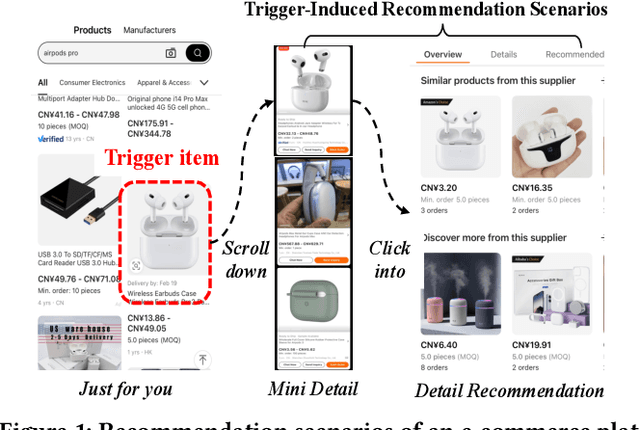Xuanzhou Liu
Modeling User Intent Beyond Trigger: Incorporating Uncertainty for Trigger-Induced Recommendation
Aug 07, 2024



Abstract:To cater to users' desire for an immersive browsing experience, numerous e-commerce platforms provide various recommendation scenarios, with a focus on Trigger-Induced Recommendation (TIR) tasks. However, the majority of current TIR methods heavily rely on the trigger item to understand user intent, lacking a higher-level exploration and exploitation of user intent (e.g., popular items and complementary items), which may result in an overly convergent understanding of users' short-term intent and can be detrimental to users' long-term purchasing experiences. Moreover, users' short-term intent shows uncertainty and is affected by various factors such as browsing context and historical behaviors, which poses challenges to user intent modeling. To address these challenges, we propose a novel model called Deep Uncertainty Intent Network (DUIN), comprising three essential modules: i) Explicit Intent Exploit Module extracting explicit user intent using the contrastive learning paradigm; ii) Latent Intent Explore Module exploring latent user intent by leveraging the multi-view relationships between items; iii) Intent Uncertainty Measurement Module offering a distributional estimation and capturing the uncertainty associated with user intent. Experiments on three real-world datasets demonstrate the superior performance of DUIN compared to existing baselines. Notably, DUIN has been deployed across all TIR scenarios in our e-commerce platform, with online A/B testing results conclusively validating its superiority.
D2Match: Leveraging Deep Learning and Degeneracy for Subgraph Matching
Jun 10, 2023



Abstract:Subgraph matching is a fundamental building block for graph-based applications and is challenging due to its high-order combinatorial nature. Existing studies usually tackle it by combinatorial optimization or learning-based methods. However, they suffer from exponential computational costs or searching the matching without theoretical guarantees. In this paper, we develop D2Match by leveraging the efficiency of Deep learning and Degeneracy for subgraph matching. More specifically, we first prove that subgraph matching can degenerate to subtree matching, and subsequently is equivalent to finding a perfect matching on a bipartite graph. We can then yield an implementation of linear time complexity by the built-in tree-structured aggregation mechanism on graph neural networks. Moreover, circle structures and node attributes can be easily incorporated in D2Match to boost the matching performance. Finally, we conduct extensive experiments to show the superior performance of our D2Match and confirm that our D2Match indeed exploits the subtrees and differs from existing GNNs-based subgraph matching methods that depend on memorizing the data distribution divergence
Do Not Train It: A Linear Neural Architecture Search of Graph Neural Networks
May 23, 2023



Abstract:Neural architecture search (NAS) for Graph neural networks (GNNs), called NAS-GNNs, has achieved significant performance over manually designed GNN architectures. However, these methods inherit issues from the conventional NAS methods, such as high computational cost and optimization difficulty. More importantly, previous NAS methods have ignored the uniqueness of GNNs, where GNNs possess expressive power without training. With the randomly-initialized weights, we can then seek the optimal architecture parameters via the sparse coding objective and derive a novel NAS-GNNs method, namely neural architecture coding (NAC). Consequently, our NAC holds a no-update scheme on GNNs and can efficiently compute in linear time. Empirical evaluations on multiple GNN benchmark datasets demonstrate that our approach leads to state-of-the-art performance, which is up to $200\times$ faster and $18.8\%$ more accurate than the strong baselines.
 Add to Chrome
Add to Chrome Add to Firefox
Add to Firefox Add to Edge
Add to Edge